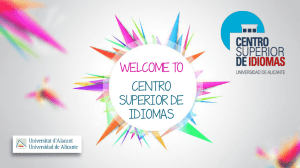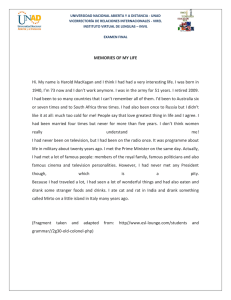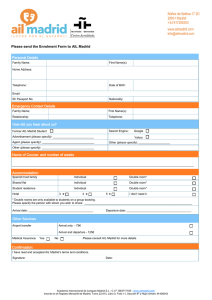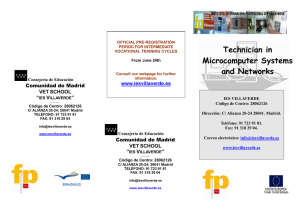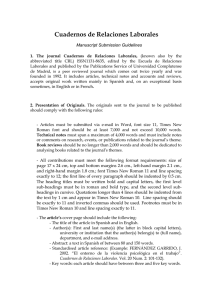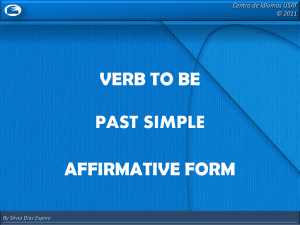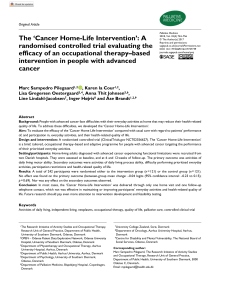Universidad CEU San Pablo
Anuncio
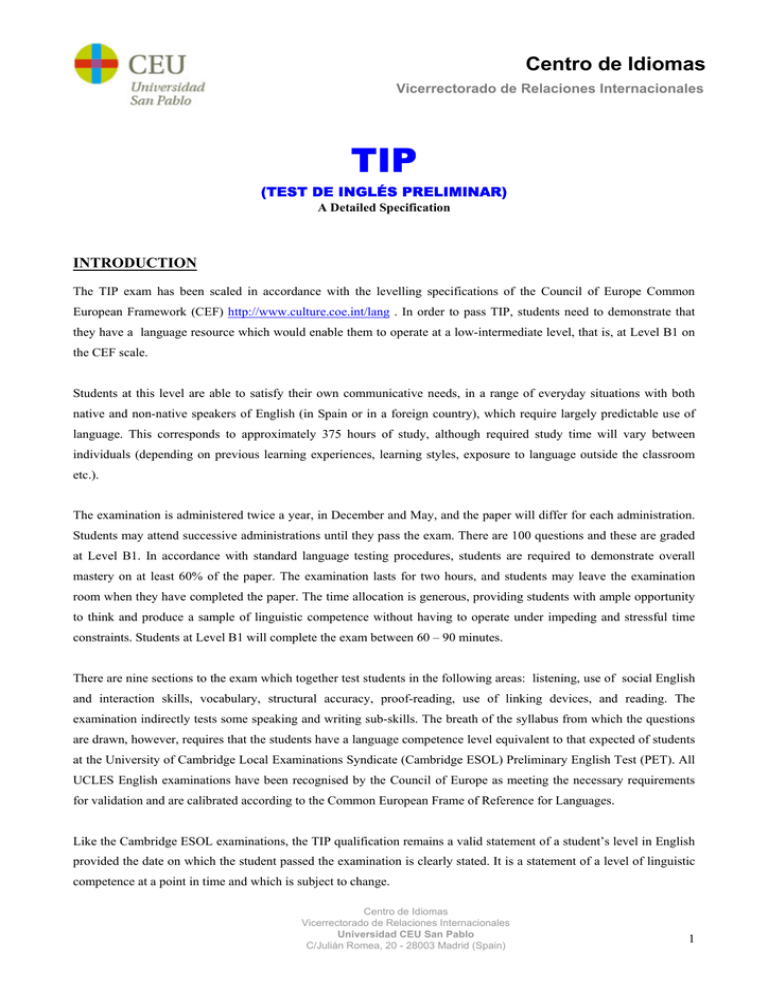
Centro de Idiomas Vicerrectorado de Relaciones Internacionales TIP (TEST DE INGLÉS PRELIMINAR) A Detailed Specification INTRODUCTION The TIP exam has been scaled in accordance with the levelling specifications of the Council of Europe Common European Framework (CEF) http://www.culture.coe.int/lang . In order to pass TIP, students need to demonstrate that they have a language resource which would enable them to operate at a low-intermediate level, that is, at Level B1 on the CEF scale. Students at this level are able to satisfy their own communicative needs, in a range of everyday situations with both native and non-native speakers of English (in Spain or in a foreign country), which require largely predictable use of language. This corresponds to approximately 375 hours of study, although required study time will vary between individuals (depending on previous learning experiences, learning styles, exposure to language outside the classroom etc.). The examination is administered twice a year, in December and May, and the paper will differ for each administration. Students may attend successive administrations until they pass the exam. There are 100 questions and these are graded at Level B1. In accordance with standard language testing procedures, students are required to demonstrate overall mastery on at least 60% of the paper. The examination lasts for two hours, and students may leave the examination room when they have completed the paper. The time allocation is generous, providing students with ample opportunity to think and produce a sample of linguistic competence without having to operate under impeding and stressful time constraints. Students at Level B1 will complete the exam between 60 – 90 minutes. There are nine sections to the exam which together test students in the following areas: listening, use of social English and interaction skills, vocabulary, structural accuracy, proof-reading, use of linking devices, and reading. The examination indirectly tests some speaking and writing sub-skills. The breath of the syllabus from which the questions are drawn, however, requires that the students have a language competence level equivalent to that expected of students at the University of Cambridge Local Examinations Syndicate (Cambridge ESOL) Preliminary English Test (PET). All UCLES English examinations have been recognised by the Council of Europe as meeting the necessary requirements for validation and are calibrated according to the Common European Frame of Reference for Languages. Like the Cambridge ESOL examinations, the TIP qualification remains a valid statement of a student’s level in English provided the date on which the student passed the examination is clearly stated. It is a statement of a level of linguistic competence at a point in time and which is subject to change. Centro de Idiomas Vicerrectorado de Relaciones Internacionales Universidad Pablo Paseo Juan XXIII, 6 – CEU 28040 San Madrid 20idiomas@ceu.es - 28003 Madrid (Spain) Tel:C/Julián 91 456 42 Romea, 00 / e-mail: 1 REFERENCES: The description of the TIP exam and syllabus (themes, skills, language, and vocabulary) is based on the following documentation: Cambridge Handbooks (KET, PET, FCE), University of Cambridge Local Examinations Syndicate – now Cambridge TESOL, (downloadable on www.cambridge-efl.org) Common European Framework of Reference for Languages: Learning, teaching and assessment. 2001, Council of Europe, Modern Languages Division, CUP Threshold 1990, J A van Ek & J L M Trim, (Revised Edition), 1998, Council of Europe, CUP Waystage 1990, J A van Ek & J L M Trim, (Revised Edition), 1998, Council of Europe, CUP http://www.culture.coe.int/lang (Council of Europe ) http://www.culture.coe.int/portfolio (Council of Europe, portfolio and self-assessment) European Language Portfolio: Guide for Developers by Gúnter Schneider and Peter Lenz, and The European Language Portfolio: a guide for teachers and teacher trainers by David Little and Radka Perclová http://www.alte.org (Association of Language Testers in Europe) http://www.dialang.org/english/ProfInt/Icanall_En http://www.dialang.org/ProfInt/Icanall_Es Centro de Idiomas Vicerrectorado de Relaciones Internacionales Universidad CEU San Pablo C/Julián Romea, 20 - 28003 Madrid (Spain) 2 1.- THEMES Language use at this level falls largely within the areas of the personal and public domains, with limited inclusion of language for vocational and professional purposes. Students at this level are able to use language relating to the following general themes: Personal identification People Personal feelings Opinions and experiences Relations with other people Social interaction Clothes House and home Daily life Shopping Food and drink Hobbies and leisure Entertainment and media Sport Medicine and exercise Health Education Places and buildings Environment Transport Services The natural world Travel and holidays Weather Language Work and jobs 2.- SKILLS Successful candidates will demonstrate competence in a selection of the following abilities, on several of the above themes in different sections of the exam. a) LISTENING (Q 1): The listening texts include public announcements and instructions, readings (from literature), radio news broadcasts, discussions, inter-personal dialogues, conversation and telephone conversations on everyday topics. At this level a student can: * Understand the main points of clear standard speech on familiar matters regularly encountered in everyday situations, including short narratives; * Understand the main points of a discussion between two standard dialect native speakers; * Understand the outline of short talks on everyday topics; * Understand a short narrative and form a hypothesis about what will happen next; * Understand announcements and operating instructions for everyday equipment; b) * Understand the main points of radio news bulletins and recorded material about everyday topics delivered relatively slowly and clearly; * Extract information of a factual nature (times, dates, etc.) from speech which will contain redundancies and language outside the defined limits of TIP; * Understand the sense of a dialogue and show appreciation of the attitudes and intentions of the speakers. INTERACTING (Q 2): Students are required to demonstrate an ability to produce common expressions used in everyday situations and expressions which enable conversation to run smoothly. At this level a student can: * Produce conversational exchanges using a standard range of expressions in everyday conversational situations (eg. likely to arise whilst staying or travelling in an area where the language is spoken) to: greet people and respond to greetings; ask for and give details; ask and answer questions; ask for and give information; talk about how to operate things; express purpose, cause and result, and give reasons; draw simple conclusions and make recommendations; make and grant/refuse simple requests; make and respond to offers and suggestions; express and respond to thanks; give and respond to invitations; give advice; give warnings and prohibitions; persuade and ask/tell people to do something; express obligation and lack of obligation; ask and give/refuse permission to do something; make and respond to apologies and excuses; pay compliments; criticise and complain; sympathise; express preferences, likes and dislikes (especially about hobbies and leisure activities); talk about physical and emotional feelings; express opinions and make choices; express needs and wants; express (in)ability in the present and in the past; talk about (im)probability and (im)possibility; express degrees of certainty and doubt. (The above list will include the use of the following modals: can (ability; requests; permission); could (ability; possibility; polite requests); would (polite requests); will (offer) shall (suggestion; offer); should (advice); may (possibility); might (possibility); have (got) to (obligation); ought to (obligation); must (obligation); mustn’t (prohibition); need (necessity); needn’t (lack of necessity); used to + infinitive (past habits)). * Formulate expressions in everyday conversational situations to: ask for repetition and clarification; reformulation or elaboration; initiate conversation; invite others into a conversation; re-state what has been said; check on meaning and intention; help others to express their ideas; interrupt a conversation; start a new topic: change the topic; resume or continue the topic; ask for and give the spelling and meaning of words; express agreement and disagreement, contradict people, use circumlocution phrases to signal a lack of understanding; close a conversation. Centro de Idiomas Vicerrectorado de Relaciones Internacionales Paseo Juan XXIII, 6 – 28040 Madrid Universidad CEU San Pablo Tel: 91 456 42 00 / e-mail: idiomas@ceu.es C/Julián Romea, 20 - 28003 Madrid (Spain) 3 c) READING including writing sub-skills (Q 5, 6, 7, 8): The texts for reading questions include extract from magazines, newspapers, leaflets, advertising material, packaging and labelling on goods, notes and messages, brochures, personal letters, brief reports or notes asking for or conveying simple information. and short official documents. At this level a student can: * Understand significant points and ideas in reading texts on concrete everyday topics containing reference, conjunction and simple lexical substitution; * Follow a line of argument; * Scan texts and locate relevant facts and information * Identify unfamiliar words and deduce phrase and sentence meaning from context in texts about everyday concerns; * Understand the plot of a clearly structured story and recognise the most important events and their significance; * Understand the opinion of writer to the material and the effect it is intended to have on the reader * Proof-read and make form corrections in written texts on everyday life topics (eg. personal details, education, qualifications and skills, family, hobbies, travel, routines and habits, past and current events, future plans and intentions etc.) which: contain straightforward, detailed descriptions, describe experiences and events, feelings and reactions, express thoughts and personal opinions, pass on routine factual information, give reasons and explanations for opinions, plans and actions, describe basic details of unpredictable occurrences (eg. an accident) or describe the plot of a book or film and describe reactions; * Use appropriate linking devices to signal the relationship between clauses where the relationship is: Conjunction (and, also, too, either...or, not.....either); Opposition (but, or, however); Sequence (first, second, next, then, finally); Temporal (when, while, until, before, after, as soon as, for, since, until, still, yet); Spatial (where, in which); Reason (because, so that, in order to); Condition (if, unless) 3.- LANGUAGE At this level students should have enough language to express themselves on topics such as family, hobbies and interests, work, study, travel and current events. a) VOCABULARY (Questions 3, 9). TIP vocabulary is that which occurs in everyday native speaker communication using English today. Students at this level can: * Produce exponents to perform the language functions listed above * Produce compound nouns and, multi-word verbs in themes listed above b) * Select appropriate vocabulary from close synonyms commonly used in the themes listed above * Demonstrate an awareness of collocation in terms used in everyday native speaker communication in the themes listed above STRUCTURE (Q 4) Within the domains and themes specified above students should be able to use the following grammatical forms (in simple and compound sentences): Verbs: Regular and irregular forms Tenses: Present simple for states, habits, systems and processes (and verbs not used in the continuous form); Present continuous for future plans and activities, and present actions; Present perfect simple for recent past with just; indefinite past with yet, already, never, ever; unfinished past with for and since; Past simple for past events; Past continuous for parallel past actions and continuous actions interrupted by the past simple tense; Past perfect simple for narrative, reported speech; Future with going to; Future with present continuous and present simple; Future with will and shall: offers, promises, predictions, etc.. Verb Forms: Affirmative, interrogative, negative; Imperatives; Infinitives (with and without to) after verbs and adjectives; Gerunds (-ing form) after verbs and prepositions; Gerunds as subjects and objects; Passive forms: present and past simple; Verb + object + infinitive give/take/send/bring/show + direct/indirect object; Causative have/get; So/nor with auxiliaries Compound Verb Patterns: Phrasal verbs and verbs with prepositions Centro de Idiomas Vicerrectorado de Relaciones Internacionales Universidad CEU San Pablo 42 00 / e-mail: idiomas@ceu.es Tel: 91 456Romea, C/Julián 20 - 28003 Madrid (Spain) 4 Conditional Sentences: Type 0: An iron bar expands if/when you heat it. Type 1: If you do that again, I’ll scream. Type 2: I’d lend you the money if I had it., If I were you I wouldn’t do that again. Simple Reported Speech: Statements, questions and commands: say, ask, tell, eg. He said he felt ill. I asked her if I could leave. No one told me what to do. Indirect and embedded questions: know, wonder, Do you know what he said? I wondered what he would do next. Interrogatives: What, What (+ noun); Where; When; Who; Whose; Which; How; How much; How many; How often; How long; etc.; Why (including the interrogative forms of all tenses and modals listed in the Social English/Interactive skills section) Adverbs: Regular and irregular forms. Manner: quickly, carefully, etc.; Frequency: often, never, twice a day, etc.; Definite time: now, last week, etc.; Indefinite time: already, just, yet, etc.; Degree: very, too, rather, etc.; Place: here, there, etc.; Direction: left, right, along, etc.; Sequence: first, next, etc.; Sentence adverbs: too, either, etc.; Pre-verbal, post-verbal and end-position adverbs; Comparative and superlative forms (regular and irregular) Nouns: Singular and plural (regular and irregular forms); Countable and uncountable nouns with some and any; Abstract nouns; Compound nouns; Complex noun phrases; Genitive: ‘s & s’; Double genitive: a friend of theirs. Pronouns: Personal (subject, object, possessive); Reflexive and emphatic: myself, etc.; Impersonal: it, there; Demonstrative: this, that, these, those; Quantitative: one, something, everybody, etc.; Indefinite: some, any, something, one, etc.; Relative: who, which, that, whom, whose Determiners: a + countable nouns; the + countable / uncountable nouns Adjectives: Colour, size, shape, quality, nationality; Predicative: alive, ill, well etc. ; Attributive: daily, weekly etc. ; Cardinal and ordinal numbers; Possessive: my, your, his, her, etc.; Demonstrative: this, that, these, those; Quantitative: some, any, many, much, a few, a lot of, all, other, every, etc.; Comparative and superlative forms (regular and irregular): (not) as . . . as, not . . . enough to, too . . . to; like, the same as, Order of adjectives; Participles as adjectives; Compound adjectives (eg. first class, fair-haired) Prepositions: Location: to, on, inside, next to, at (home), etc.; Time: at, on, in, during, etc.; Direction: to, into, out of, from, etc.; Instrument: by, with; Miscellaneous: like, as, due to, owing to, etc.; Prepositional phrases: at the beginning of, by means of, etc.; Prepositions preceding nouns and adjectives: by car, for sale, at last, etc.; Prepositions following (i) nouns and adjectives: advice on, afraid of, etc. (ii) verbs: laugh at, ask for, etc. Note: In the TIP exam students will meet other forms and structures in texts, but they will only be tested on those above. Centro de Idiomas Vicerrectorado de Relaciones Internacionales Universidad CEU San Pablo C/Julián Romea, 28003 Madrid (Spain) Paseo Juan XXIII,20 6 –- 28040 Madrid Tel: 91 456 42 00 / e-mail: idiomas@ceu.es 5 STUDY MATERIALS In order to prepare for the TIP examination, students could use any of the standard coursebooks (with teachers), grammar and vocabulary references and dictionaries intended for adults and which take learners up to a pre-intermediate level. Here are some examples: a) COURSEBOOKs (not designed for self-study) English File (Books 1 and 2), Clive Oxenden, Cristina Latham-Koenig, Paul Seligson, Oxford University Press or New Headway English Course (Beginner, Elementary, Pre-Intermediate), John and Liz Soares, Oxford University Press or International Express (Elementary and Pre-intermediate), Liz Taylor, Oxford University Press b) SOFTWARE (designed for self-study and available at the university Language Laboratories NetLanguages English Express Tense Buster TIP-type exercises c) GRAMMAR / VOCABULARY REFERENCES (designed for self-study) * The Good Grammar Book (Elementary to lower-intermediate, with answers), Michael Swan, Catherine Walter, Oxford University Press * Essential Grammar in Use (Elementary and Lower Intermediate) Raymond Murphy, Cambridge University Press * English Vocabulary in Use (Elementary and Pre-Intermediate), Stuart Redman, Cambridge University Press d) DICTIONARIES * Oxford Basic English Dictionary * Collins Pocket Plus (Español - Inglés) * Diccionario Cambridge Klett Pocket etc................... Centro de Idiomas Vicerrectorado de Relaciones Internacionales Universidad CEU San Pablo C/Julián Romea, 206 -–28003 Madrid (Spain) Paseo Juan XXIII, 28040 Madrid Madrid (Spain) Tel: 91 456 42 00 / e-mail: idiomas@ceu.es 6

